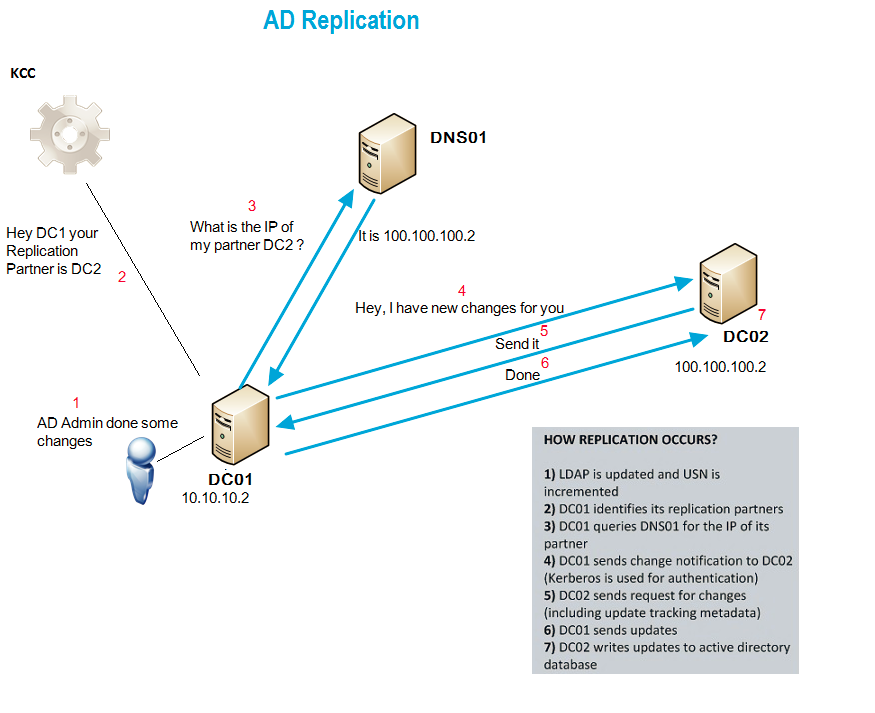AD Replication Process Overview
AD Replication Process Overview
So what's the big deal with AD Replication? I mean it's obvious that your infrastructure has multiple Domain Controllers and you want to make sure that Active Directory talks to each other directly or indirectly and keep each other up to date. We came up with Replication concept.
Now it's important that Domain controller talk to right domain controller, I mean there should not be any confusion, everyone should be aware who is sending update and receiving updates from whom. So we came up with KCC concept ( Knowledge Consistency Checker - it helps to design the replication topology automatically)
Now too much talking between AD Servers are also not good, each site is connected using very costly WAN link and I am sure any company don't want any useless replication happening via these costly links. So we came up with concepts like Site Link Cost, Replication Schedule.
Trust me AD Replication is a huge topic. This article one pretty much explains basic replication concept between 2 DC's.
Active Directory (AD) is a multi-master directory, meaning each directory services server—referred to as a domain controller—contains a fully readable and writeable copy of the directory
services database. Because all domain controllers can accept changes to the database, some method is needed to replicate those changes to other domain controllers, ensuring a consistent
database across all domain controllers. This scheme is referred to as AD replication.
AD replication can be broken down into four basic operational components:
WHO
It is a list of servers that participate in replication and the servers with which they replicate. Referred to as a replication topology, this list is generated by a special AD component called the Knowledge Consistency Checker (KCC).
Checking replication Topology - https://technet.microsoft.com/en-us/library/cc739234(v=ws.10).aspx
WHAT
It is the information that is being replicated. AD uses attribute-based replication and versioning to determine which information has changed and requires replication.
https://windowsitpro.com/active-directory/active-directory-replication-depth
WHEN
It is a schedule that determines when replication will occur. Separate schedules exist for replication within an AD site and for each link connecting different sites.
Managing Replication between sites- https://technet.microsoft.com/en-us/library/cc961783.aspx
HOW
It defines how the replicated data is physically transported across the network.
Site Replication
- Replication traffic is not compressed to save processor processing.
- Replication partners notify each other when changes need to be replicated, to reduce replication latency.
- Replication partners poll each other for changes on a periodic basis.
- Replication uses the remote procedure call (RPC) transport.
- Replication connections can be created between any two domain controllers located in the same site. Connections can be made with multiple domain controllers to reduce replication latency.
Inter-site Replication
- Replication traffic is compressed to save bandwidth.
- Replication partners do not notify each other when changes need to be replicated, to save bandwidth.
- Replication partners poll each other for changes on a specified polling interval, during scheduled periods only.
- Replication uses the TCP/IP or SMTP transport.
- Replication connections are only created between bridgehead servers (servers that handles all inter-site replication for that domain). Connections between bridgehead servers using the lowest cost route, according to site link cost. Connections will only be created over higher cost routes if all of the domain controllers in lower cost routes are unreachable.
To know more about AD replication please refer to below articles:
https://technet.microsoft.com/en-us/library/cc961788.aspx
https://technet.microsoft.com/en-us/library/cc755994(v=ws.10).aspx#w2k3tr_repto_how_uvgz
Troubleshooting Replication: https://technet.microsoft.com/en-us/library/cc755349(WS.10).aspx\#BKMK\_1
